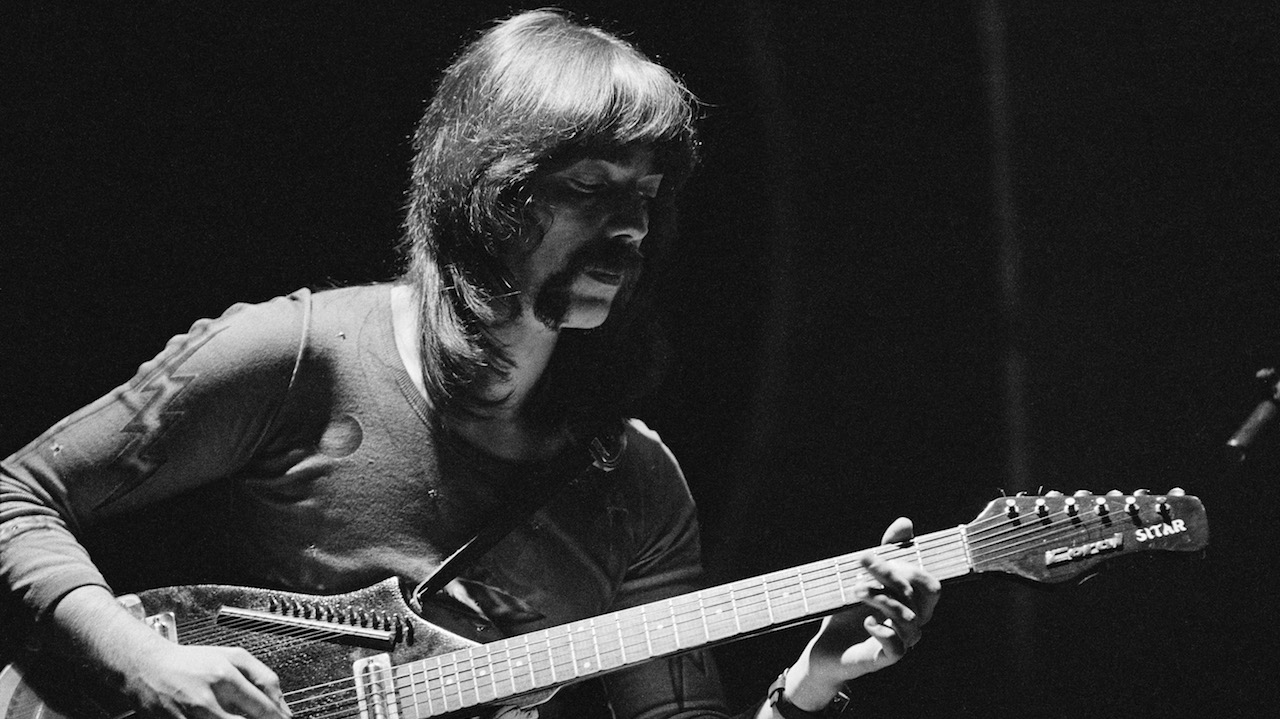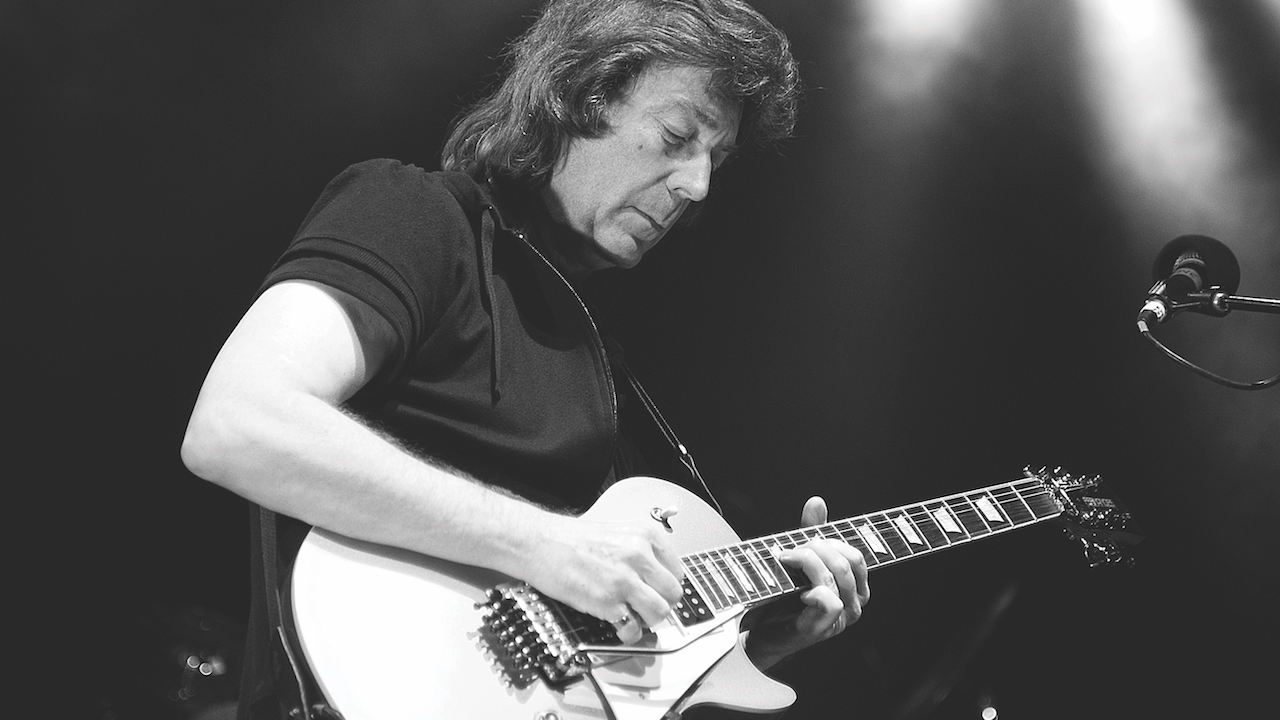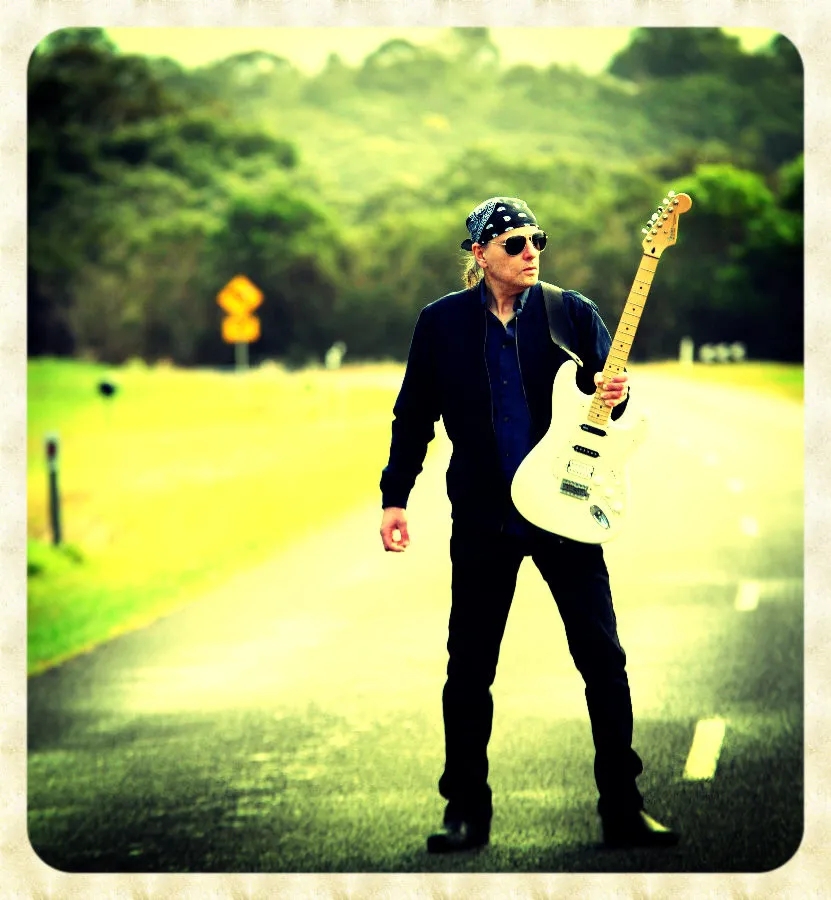“It's all about Bach and Beck. Before Beck, guitars used to just go ‘twang.’ Then they learned to sustain and scream and impersonate a woman’s voice and imitate brass instruments." The career and influences of Steve Hackett in five songs
Prog legend, innovator and “musical chameleon”, Steve Hackett spent six years in Genesis before a stellar solo career delving into everything from classical to blues and beyond. Here are five Genesis cuts he considers his best

During the course of an illustrious career that has lasted more than 50 years, Steve Hackett has consistently explored a diverse musical cocktail, delving into everything from prog-rock and classical to blues and beyond.
After making a name for himself as a guitarist with several English outfits in the late 1960s, including pop-rockers Quiet World, he came to worldwide acclaim with the English prog-rock group Genesis in 1971, featuring singer Peter Gabriel, drummer Phil Collins, keyboardist Tony Banks and bassist Mike Rutherford.
Hackett’s highly skilled technique and stylistically mixed bag were integral contributions to the group’s ever-evolving sound on the six studio albums he contributed guitar to, but he departed Genesis in late 1977 to pursue a hugely prolific solo career that continues today.
Along the way, Hackett found time in the mid 1980s to assemble the short-lived supergroup GTR with Steve Howe from Yes, as well as appear as guest guitarist on numerous recordings by artists such as Box of Frogs, John Wetton and Steven Wilson, to name but a few.
Yet, it’s his early work with Genesis that saw him inducted in the Rock and Roll Hall of Fame in 2010, firmly solidifying his position in the pantheon of influential guitar greats.
An innovative and creative guitarist of the highest order, he set the standard for many of the approaches and techniques that have become the vocabulary of any modern-day guitarist’s modus operandi. His pioneering use of right-hand tapping is but one example.

Exceptionally proficient on both acoustic and electric guitars, Hackett has a visionary six-string approach that’s informed by the musical masters, stretching from the works of Baroque composer and keyboardist J.S. Bach right to the unorthodox six-string artistry of the late great Jeff Beck.
All the latest guitar news, interviews, lessons, reviews, deals and more, direct to your inbox!
“It always comes back to Bach and Beck,” Hackett affirms. “If it’s first-inversion chords, and churchy changes, it’s all Bach, while Beck informs my every note on electric guitar. Before players like him, guitars used to just go ‘twang.’ Then they learned to sustain and scream and impersonate a woman’s voice and imitate brass instruments.
“I was fooled when I first heard the Stones doing ‘Satisfaction,’ as I thought it was a brass section or a trumpet. I had no idea at the time that it was a guitar! I realized at that moment, that was where the guitar was heading, that it was going to be impersonating all these things. Guitar was the synthesizer before the synthesizer.”
The following five songs, all from Hackett’s Genesis oeuvre, showcase some of his finest envelope-pushing moments on record. “I think we were very good for each other, and I think I pushed them as much as they pushed me,” he says of his time with the group. “It wasn’t always easy at times, and we struggled to keep a lid on some of the arguments, but Genesis at its best was absolutely mighty.”
“Horizons” Foxtrot (1972)
“I was writing very, very slowly and noodling away on this thing for about a year. I had no idea that Genesis would use it, but I played it one day to the band, and Phil was the first one to say, ‘I think we should use that, as it sounds like there ought to be applause after it.’ It was surprising, as I was still the new boy with the band.
“I played it on a friend’s borrowed Yamaha steel-string. Whenever I’ve played it in recent times, it’s usually on a nylon-string guitar, which seems to suit it better.
“It’s a Bach variation in spirit. If you’re really looking for where it came from, there’s a reference to Bach’s Cello Suite No. 1. While the Foxtrot album is pretty much a futuristic-sounding album, there are moments where it goes right back to that great keyboard player, Johann Sebastian Bach. No one’s ever been quite that good since.
It’s a Bach variation in spirit. If you’re really looking for where it came from, there’s a reference to Bach’s Cello Suite No. 1
“It was done in one take, though I had to do four to get it right. The strings on the Yamaha are grouped very closely together on its narrow fretboard.
“The song’s length was influenced by ‘The Earle of Salisbury,’ by English composer William Byrd, who was before Bach. I first heard John Renbourn do a version on his album Sir John Alot of Merrie Englandes Musyk Thyng & Ye Grene Knyghte. It was a great record that he did just prior to forming Pentangle with Bert Jansch.
”I loved the idea that the tune, written by a Tudor composer, was just the perfect little piece, at only a minute and half long, so I too deliberately wrote something to last a minute and a half. Therefore, it was able to slot into the Genesis canon without disturbing the waters too much, as an interlude to ‘Supper’s Ready,’ which is an epic tune.
“We never did anything quite that long before or after. I’m proud of it as a little piece. It’s written in an ancient style, and though not the work of a modern brain. It’s the work of a brain impersonating the old masters.”
“Firth of Fifth” Selling England by the Pound (1973)
“Tony came in with the initial idea for the tune. Peter liked the melody line and said it sounded very much like the blues, but to me it seemed more like gospel in a way, as the verse has a gospel feel to it. The song’s strength is characterized by the instrumental work throughout it. It’s the thing that people refer to as typically progressive, but at the time we didn’t know that we were doing something that was going to be referred to as progressive.
“I really like it a lot. Tony originally had the melody on piano, and then we tried it on flute, but I wanted to try it on guitar as I had just gotten hold of a certain combination of toys: an Echoplex and a Colorsound Tone Bender fuzz box, which was a copy of a Marshall Supa Fuzz.
“Along with my 1957 goldtop Les Paul, which went into a 1971 100-watt Hiwatt amp, the serendipity of those things coalesced into this perfect guitar solo for that song. It’s probably the most well-known one in the Genesis canon — the go-to one.
It’s a memorable and very melodic solo, and it’s there in the pantheon. You know it and can hum it, and my mom likes it so much she tears up every time she hears it
“It was based a little bit on the work of the French minimalists, as the melody itself is very Erik Satie–esque. The way I interpreted it was to do it with bends, so it sounded weird, sustaining and unheard of. I got to do a three-and-half-minute guitar solo in the middle of another tune, which itself came out to something like 10 minutes.
“It’s a substantial part of the song, and I think it’s a beautiful piece of music. And for me it’s all about the guitar solo.
“I’d like to think that I’m sufficiently detached to say that’s where the song soars and is at its best. It’s a memorable and very melodic solo, and it’s there in the pantheon. You know it and can hum it, and my mom likes it so much she tears up every time she hears it. It showcases the band using rock instruments but sounding at their most symphonic. ‘A rock group impersonating an orchestra’ comes very close to describing it. One of Genesis’s best.”
“Here Comes the Supernatural Anaesthetist” The Lamb Lies Down on Broadway (1974)
“This song really came together out of Mike and I working together. He was playing these chordal parts, and I wrote a lead line over the top of them. It’s got this very haunting rhythm to it, but it’s also very melodic and quirky and fits the album perfectly. We were trying to be very different from everything we’d done before, and though there were moments when we succeeded, at other times there are moments on the album where I feel it wanders off the plot, as double albums tend to do.
“Phil had started experimenting with recording his voice at half speed, so that when you played it back you had this kind of Mickey Mouse–sounding voice. It was a trick he used more and more after he became the lead singer of Genesis.
“You’ve got to remember this was crafted during the era of Peter Gabriel as lead singer, with Phil doing backup. Here you got a glimpse at some of those vocal textures that Phil would employ later when he could do it himself.
Phil was a guy full of a lot of suppressed ideas, and with very clever rhythmic ones. Sometimes he'd be able to take a melody and change the whole feel by changing the rhythm of it
“He was a guy full of ideas and obviously full of a lot of suppressed ideas, and with very clever rhythmic ideas. Sometimes he’d be able to take a melody and change the whole feel by changing the rhythm of it.
“I think maybe if he had gained a little more confidence in an album or two’s time, he probably would’ve taken that track and made it swing a little bit more. It does something that’s more angular and stranger.
“I again used my Gibson Les Paul, an H&H transistor amp and the Tone Bender fuzz box. I was also using two Leslie cabinets. Because this was before chorus and pitch shift had been invented, I’d put my guitar through the Leslie to give it a chimey sound. I had one track that was Leslie-d and one that went straight.
“With the Les Paul not being a very bright-sounding guitar, I had to turn up the treble quite a bit or give it some kind of boost in that department, but because it was a very gutsy guitar, it sounded very smooth.”
“It” The Lamb Lies Down on Broadway (1974)
“Mike had this Shergold electric 12-string and liked to put it in strange tunings. I’m not sure exactly what tuning he had for this, but the main thrust of it came from a guitar-strumming idea and from that we all added things to it. There’s quite a lot of lead guitar work, which I wrote and which was also doubled on keyboard.
“It’s got a quirky lyric from Peter too, and I felt we were sounding a little bit like what other bands were doing with the 12-string at the time — a bit like the Byrds — while the guitars and synth together were sounding a bit like Yes.
“The tune came together very much live and was at its strongest in the live setting, where Peter would depict a Puerto Rican punk with a leather jacket with makeup on. There was also this very lifelike dummy that was brought on for ‘It’ during the live performance. And because there were strobes on either side of the stage, you couldn’t tell which was the real Peter Gabriel and which was the very lifelike dummy, as this thing looked uncannily alive even at close quarters.
“I think the live presentation of ‘It’ was all-important to making this thing work, especially as it was the tour de force that closed the album.”
“Ripples” A Trick of the Tail (1976)
“It was typical of Genesis to use more than one 12-string guitar. Mike and I both had acoustic Zemaitis 12-string guitars. As he was playing right down the bottom of the neck and getting all those open-string sounds, I decided to do something else a whole octave higher up the fretboard, as I wanted to sweeten it and make it very chocolate box.
“You’ll be forgiven for thinking that my part was recorded at half speed; it was actually done in real time. When we got to the middle section, it just kept paddling around a few changes, so I thought it needed something to save the day.
“I was working with a piece of kit called the EMS Synthi Hi-Fli. It had the ability to cut off the front of the note, a bit like fading it in, so it sounded like you were playing backward. It also had a compressor that made the notes sustain for a very long time and kept the same dynamic, and with a very thin kind of distortion. I never really found any other piece of kit that really distorted quite like that thing.
So I did a forward guitar solo that attempted to sound like a backward guitar solo, and then we put a pre-echo on it. And because this is preempted by genuine backward stuff, you get this highly confusing combination of what’s forward and what’s backward
“So I did a forward guitar solo that attempted to sound like a backward guitar solo, and then we put a pre-echo on it. And because this is preempted by genuine backward stuff, you get this highly confusing combination of what’s forward and what’s backward. I also wanted to come up with a melody that would be memorable.
“People always mention ‘Firth of Fifth’ as my best guitar melody, but actually I’m very fond of this one because of the sort of poignant nature of the way the guitar functions on it. It doesn’t really sound much like a guitar at all; it sounds more like something that Chopin might have written for a string section. It’s my personal best.
“It’s a brilliant little tune. The sound is very subtle, unique and very atmospheric, and very Genesis, and very much what we got into on the subsequent album, Wind & Wuthering, which followed, and which had that sort of poignant thing going on too.
“I think Mike picked up on what I was trying to do at the time, writing things that could be part of very romantic film scores. I think it’s one of Genesis’s best little tunes, and it’s got the best of what 12-strings can do and the best of what an electric guitar can do.”
For more on Steve Hackett, visit his website. His new album Foxtrot at Fifty, is available to buy and stream now
Joe Matera is an Italian-Australian guitarist and music journalist who has spent the past two decades interviewing a who's who of the rock and metal world and written for Guitar World, Total Guitar, Rolling Stone, Goldmine, Sound On Sound, Classic Rock, Metal Hammer and many others. He is also a recording and performing musician and solo artist who has toured Europe on a regular basis and released several well-received albums including instrumental guitar rock outings through various European labels. Roxy Music's Phil Manzanera has called him "a great guitarist who knows what an electric guitar should sound like and plays a fluid pleasing style of rock." He's the author of two books, Backstage Pass; The Grit and the Glamour and Louder Than Words: Beyond the Backstage Pass.






